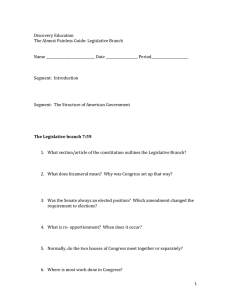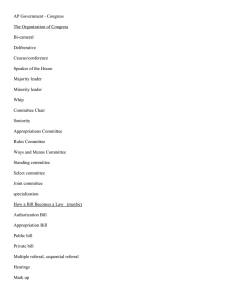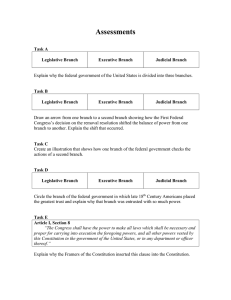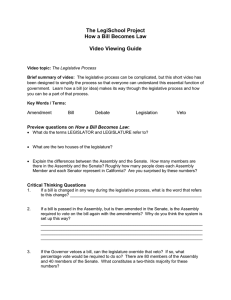I. Intro II. Legislative Decision Making Process
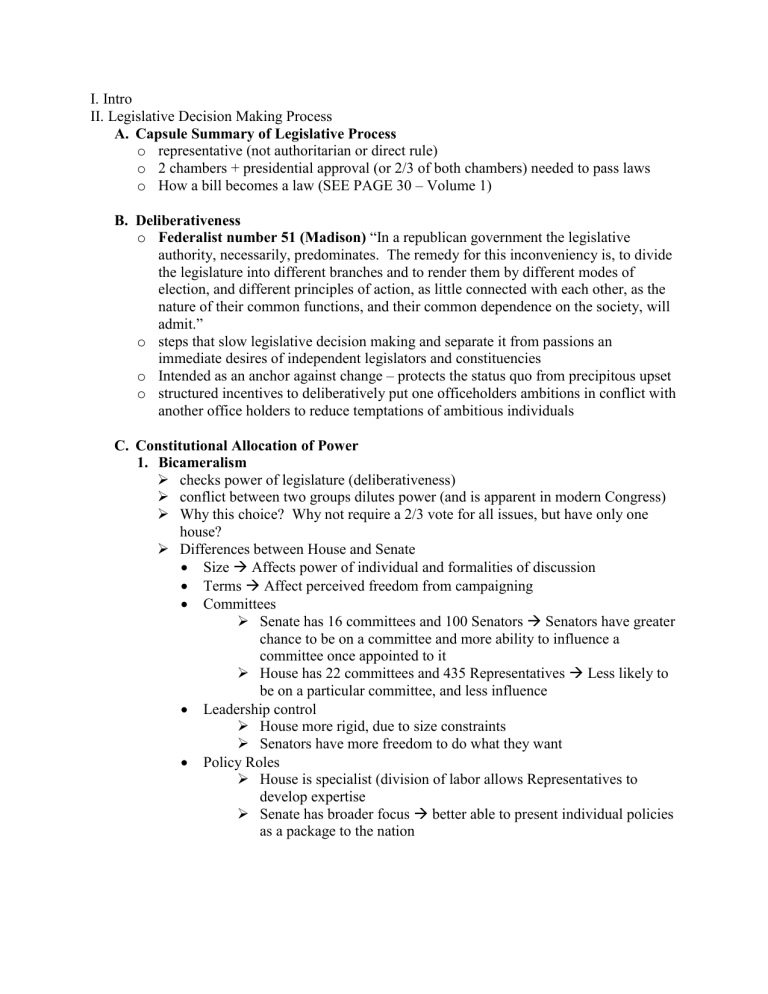
I. Intro
II. Legislative Decision Making Process
A.
Capsule Summary of Legislative Process o representative (not authoritarian or direct rule) o 2 chambers + presidential approval (or 2/3 of both chambers) needed to pass laws o How a bill becomes a law (SEE PAGE 30 – Volume 1)
B.
Deliberativeness o Federalist number 51 (Madison)
“In a republican government the legislative authority, necessarily, predominates. The remedy for this inconveniency is, to divide the legislature into different branches and to render them by different modes of election, and different principles of action, as little connected with each other, as the nature of their common functions, and their common dependence on the society, will admit.” o steps that slow legislative decision making and separate it from passions an immediate desires of independent legislators and constituencies o Intended as an anchor against change – protects the status quo from precipitous upset o structured incentives to deliberatively put one officeholders ambitions in conflict with another office holders to reduce temptations of ambitious individuals
C.
Constitutional Allocation of Power
1.
Bicameralism
checks power of legislature (deliberativeness)
conflict between two groups dilutes power (and is apparent in modern Congress)
Why this choice? Why not require a 2/3 vote for all issues, but have only one house?
Differences between House and Senate
Size
Affects power of individual and formalities of discussion
Terms
Affect perceived freedom from campaigning
Committees
Senate has 16 committees and 100 Senators
Senators have greater chance to be on a committee and more ability to influence a committee once appointed to it
House has 22 committees and 435 Representatives
Less likely to be on a particular committee, and less influence
Leadership control
House more rigid, due to size constraints
Senators have more freedom to do what they want
Policy Roles
House is specialist (division of labor allows Representatives to develop expertise
Senate has broader focus
better able to present individual policies as a package to the nation
INS v. Chada (congressional veto provisions)
reviewed a statute that gave power for either House or Senate to override
Attorney General’s decision to suspend deportation of a person
amounted to a one house veto
convienience and usefulness do not trump constitutionally “profound conviction of the Framers that the powers conferred on Congress were the powers to be most carefully circumscribed.”
Critical question: Is the act legislative o If legislative
Constitution says must be constitutional o Delegation of power to AG is legislative any attempt to undo must also be legislative
Legislative veto invalid under presentment clause – need two houses and presidential presentment to be a valid law
2.
Interlude: Particularized Legislative Action
3.
Traditional Veto
Source of Presidential Power
check over legislative tyranny
not absolute, but very hared to overturn (exception is pocket veto)
originally reserved for unconstitutional bills, but later expanded to anything the pres. disliked
Pocket Veto – If the president fails to return a bill within ten days, excepting
Sundays, it becomes law, “unless Congress by their Adjournment prevent its
Return, in which Case, it shall not be a Law.”
Pocket Veto Case (oldest)
Return to an agent doesn’t qualify b/c (1) delivery to an authorized agent would create uncertainty whether there was a timely return (2) there would be a substantial delay in determining Congress’s reaction to a veto
Wright v. US
No pocket veto when 10th day fell during a 3-day adjournement of the Senate only, where organizations of the Senate continued and remained intact
To rule in favor of a pocket veto, must show that the president was unable to exercise his veto because of an adjournment
mere absence not enough if (a) there is an authorized agent and (b) there is no substantial delay
Barnes v. Kline (most recent)
Given the appointment of an agent, the established Congressional rules for carry-over business, and the short duration of an adjornment
return is not prevented by an adjournment
4.
Line Item Veto
Sego (NM)
Attempt to defeat legislative will and defeat a legislative condition precedent fails
Kleczka (Wisconsin)
Governor changed an optional $1 add-on on taxes for election costs into a $1 check-off
Governor’s veto left a workable law
severable
Since governor’s veto power is co-extensive with legislature’s power to enact
Veto works even though it changes policy
The idea that line-item vetoes limit budgets is not very true
Governor/President typically use the line-item veto to shape budget, without actually reducing it
Legislation tends to add additional projects it knows will be axed
Clinton v. NY
Invalidated the line-item veto for federal laws
Bill permitted president to cancel parts of a bill only if it (i) reduced the
Federal budget deficit, (ii) didn’t impair any essential Government functions, and (iii) didn’t harm the national interest.
Distinguished use of line item veto from case where the president acts according to a bill that requires him to lift suspension on import duties
“whenever, and so often” as he should find that an importing country imposed duties on the US that the president deemed to be “reciprocally unequal and unreasonable”
Distinction lies in discretion. In line-item veto, president has discretion to do what he wants, where in duty case, president is constrained – he has to do something if certain conditions are met (even if that determination is done by the president).
D.
Constitutionalized Enactment Procedure
1.
State Procedural Rules – an intro
Congress has freedom to add riders that most state legislatures don’t have
Fear of laws being “smuggled” in larger bills against public wishes
Danger of rule is that it affects efficiency of legislative compromise and causes invalidation of valid laws on technical grounds
2.
Enrolled Bill Rules in the state
Tuck v. Blackmon (Misssissippi) o Legislator sued for an injunction to stop a bill from being enacted after she failed to have the conference reports read aloud per a Senate rule o “Only after heightened consideration and under exigent circumstances will judicial authority to regulate the internal actions of the Legislature be exercised” o Due to separation of powers, courts should refrain from unnecessarily interfering with legislative internal rules o Courts should not declare legislative rules unconstitutional unless those rules are “manifestly beyond the Senate’s constitutional ability” o “The duty of the courts begins with the completed act of the legislature”
o Courts typically allow the legislature the ability to decide its own rules, since legislature is coequal, and legislative rules only apply to legislators o However, courts have power to act when an interpretation is “grossly unreasonable
” and the “legislative process has suffered substantial
harm”
D&W Auto Supply o Kentucky Constitution stated “Any act or resolution for the appropriation of money or the creation of debt shall, on its final passage, receive the votes of a majority of all the member elected to each house” o An appropriations bill “passed” by a vote of 48-43 in the 100 member senate (3 short of the 51 majority needed by Constitution).
o Enrolled bill doctrine stated “a court may not look behind such a a bill, enrolled and certified by the appropriate officers, to determine if there are any defects.” o Pros of Enrolled Bill doctrine
enrolled bills are “Records” at common law, and not subject to attack
courts and legislature or coequal, so courts must engage in every presumption in favor of the legislature
at time of enactment, legislative record-keeping was so inadequate, that final bills were required to have final weight
Theories of convenience discouraged requiring the legislature to preserve its records and feared expanding complex litigation o Cons
Artificial presumptions, especially conclusive ones, are not favored
produces results that do no accord with facts or Constitution
Conducive to fraud and forgery and other wrongdoings
Modern automatic and electronic record keeping eliminates an original justification
Disregards court’s primary duty to seek truth and provide remedy for wrongs committed by any branch of the government o Extrinsic Evidence Rule is favored – creates a prima facie presumption that an enrolled bill is valid, but such presumption may be overcome by clear, satisfactory evidence establishing that constitutional requirements have not been met
Three Typical Approaches enrolled bills o Enrolled Bill Doctrine
Conclusive Presumption
Relies on Separation of powers
Encourages validity of statutes so people can rely on laws (but not necessarily rely on the fact that they were constitutionally adopted) o Journal Entry Rule
Prima facie assumption of validity
Permits only evidence from the legislative journals to be admitted to rebut this assumption (unless there is sufficient legal evidence of fraud or that the legislature enacted a bill after it had ceased to legally be the legislature) o Extrinsic Evidence Rule
Prima facie assumption of validity
Any attack by clear, satisfactory, and convincing evidence is permitted to show that the constitutional requirements have not been met
Criticism: encourages inconvenience and mischief, since even the most important bills “hinge for all time upon equivocal memoranda and the frail recollection and veracity of man”
3.
Enrolled bill rules in federal courts
Field v. Clark o Act as signed was not the same as the act that was voted on, as it appeared in the journals o Constitution mandates that only acts passed by Congress are law o However, court found that evil of making every bill subject to endless second guessing was greater than the remote possibility that the Speaker,
President of the Senate, and President would all conspire to pass a law that was unsupported by Congress
Munoz-Flores o Evaluated whether an act was passed in violation of the origination clause which requires bills for raising revenue originate in the House o Attempted to determine whether it raised a nonjusticable political question by seeing if it fit into one of six categories
Commitment to another branch by Constitution
Lack of judicially discoverable and manageable standards
Impossibility of making decision without determining an underlying policy question
Impossibility of deciding without undue lack of respect to another branch
Unusual need to adhere to an already made political question
Potential to embarrass government by having different branches make multifarious pronouncements on one question o Should Court pay less attention when it is alleged that legislative majority’s rights are being impinged, given that leg majority is in a very good position to protect itself?
4.
Single-subject and germaneness rules
Dept of Ed v. Lewis o FL Constitution provides that appropriation bells have only one subject o cannot change laws other than one at hand o qualifications and restrictions must apply directly to the case at hand
o Proviso that prevented funds from being applied to post secondary schools that provided assistance or facilitates for groups that advocate of reccomend sexual relations outside of marriage
invalid
Arangold Corp. v. Zehnder o Single subject is satisfied if there is a natural and logical connection to the subject o subject is interpreted broadly in favor of upholding o each provision does not need to connect directly to other provisions, but it must be connected to main subject
E.
Internal Parliamentary Rules
1.
Enforceability and effectiveness
Metzenbaum
Act set forth means by which congress was limited in carving exceptions from the act, Congress voted (by majority) to enact exceptions in violation of the rule
Court is unwilling to rule when an issue would involve both construing a
House rule and “imposing upon the House our interpretation of its rules”
Prime ingredient of a nonjusticable political question is a textually demonstratable constitutional commitment of the issue to a coordinate branch of government
Constitution clearly empowers each house to form their own rules
Nonjusticable, although intervention may be appropriate where rights of persons other than members of Congress are violated
2.
Entrenched rules and the Filibuster
Filibuster
Constitution only lists 7 areas where a supermajority is required in either house – does not include busting a filibuster
Constitution allows each house to “determine the rules of its proceedings, punish its members for disorderly behavior, and, with the concurrence of
2/3, expel a member”
Skaggs
Appellants argued that a leg rule that required that tax increases be approved by 3/5 vote violated constitutional principles of majority rule.
court found that ability to change the rules with simple majority indicated there was no damage (just need two votes to raise taxes with less than 60%.
F.
Committees
Tend to be unrepresentative of the group as a whole (selection bias attracts people who have a particularly strong interest, regardless of whether this interest is shared by Congress as whole.
Allows for specialization and the development of expertise
If something is approved
no danger. Entire legislature has to vote to approve before it is law
Bigger danger is the ability to block legislation that they are unfavorable towards.
G.
Party Caucuses
H.
Alternative: Direct Democracy
III. The Legislator as Representative
A.
The Meaning of Representation
Trustee v. delegate theories
trustee is entitled to make his own decisions (people elect a wise man and trust his judgment
Delegate is more constrained – seeks to be voice of the people and work for what they want, regardless of his own opinions
B.
Qualifications for Office
Michel v. Anderson
Granted Puerto Rico representative ability to vote in Committee of the Whole
Protested by other reps. on grounds that their voice was lessened
Found that this use did not overreach previous powers which allowed delegates of territories to serve on committees
Powell v. McCormack
In 89th Congress, Powell was suspected of fraud and other bad acts
He was excluded from 90th Congress, even after being elected by his constituency
Alleged that he could only be excluded on issues of age, citizenship, or residency – those areas specifically mandated by Constitution
Other side argued that his exclusion had been approved by more than 2/3 vote, so even if not allowed to exclude, should count as a constitutional expulsion
Court ruled that exclusion was unconstitutional, and if the legislature wanted to expel, they had to vote to do that explicitly
IV. Safeguards against Corruption and Undue Influence
A.
Campaign Finance Regulation
1.
Contribution and Expenditure limitations
2.
Disclosure Requirements
3.
Public Financing
4.
Campaign Finance Reform and its aftermath
B.
Lobbying Regulation
C.
Criminal Liability
D.
Legislative Ethics Regulation
ON THE USES OF LEGISLATIVE HISTORY IN INTERPRETING STATUTES
Stephen Breyer
Reasonable uses of Legislative History
A.
Avoiding an absurd result
if collaterally absurd consequences, manifestly contrary to common reason arise out of statutes, those statutes are, with regard to those collateral consequences, void
Judges permitted to examine the legislative history to determine if the results truly are unforeseen (the issue really is collateral)
Before concluding that an acts is absurd, that no good reason supported it, and declaring the application void, the court should first check the history to determine if the drafters had some special purpose in mind
Least controversial use, even Scalia is down
B.
Drafting error
Even where result is not absurd
Especially where there is evidence that the statute moves away from common practice
-
Ex: A statute imposed federal criminal penalties for any person who “possesses any false, forged, or counterfeit coin, with intent to defraud.” ∆ used false Krugerrands, which are only valid currency in SA. History showed that this statute, after 150 years, was separated from the clause of the original statute that governed possession and making of counterfeit coins. Original statute was limited to false coins currently in use in the US.
This limiting language was extended to the making of the coins, but not the possession.
History indicated that this restructuring was intended for solely organizational purposes.
Ct. ruled drafting error.
C.
Specialized meaning
explaining meanings of terms or phrases in a statute which were previously understood by the community of specialists (or others) particularly interested in the statute’s enactment
D.
Identifying a reasonable purpose
The purpose a word serves within the broader context of a statutory scheme in order to decide properly whether a particular circumstance falls within the scope of that word or phrase
Allows courts to take advantage of the work done by Congress, who in the process of passing the bill, become an informed community. This expertise is likely to aid in the production of a more workable statute.
Increases the likelihood that the law will do what the legislature (and those who relied on the legislature) reasonably expected it to
E.
Choosing among reasonable interpretations of a politically controversial statute
A statute that evokes strong political support and opposition in Congress can include language that is unclear or silent on an important issue
Causes critics the greatest concern, as it creates the greatest likelihood that testimony will be raised to the level of the statutory language
Allowing legislators to signal their intent is more efficient, since the more general tone of the history allows compromises to be made
Allowing the vaguer language allows the court to tailor relief in a way that’s most appropriate for the case at hand, while statutory rules would have to be binding
Disallowing courts to look at leg history in these cases would also be unfair, since
Congress expected it to be a part of the interpretation when it was enacted
Criticisms of the Use of Legislative History
A.
Lack of utility
often more vague than the statute to be interpreted
Weak argument, since leg history that is vague in a case is of low probative value due to its vagueness (not merely because it’s leg history)
Different when applied to SC than other Federal courts. Many SC cases reflect political controversy where the opposing sides “leave no leg history stone unturned in their efforts to influence subsequent judicial interpretations. Other courts typically have cases where there is confusion unrelated to political controversy, and leg history is often of great usefulness.
B.
Constitutional arguments
According to the Const, the only thing that is a law is what has passed by a majority in both houses and been signed by the president. Leg history does not, therefore, using leg history to influence interpretation is unconstitutionally raising it to the level of statute.
Const vests leg power in elected representatives, not lobbyists or staffers. Yet, these unelected officials often are the authors of leg history
Both arguments overstate their claim. Leg history is not raised to level of law. Rather it is used to interpret the law. These criticisms would also have to apply to use of dictionaries, common practice, or congressional lexicographers (none of which are considered suspect)
The workings of Congress are complex and bureaucratic, and there is nothing unconstitutional about allowing a representative to delegate to staffers T
There is no guarantee that the statute is any more reflective of direct influence of the legislator, since his or her involvement is a function of the importance of the substantive procedural or political issues, not the category of the text
C.
The problem of congressional “intent”
-
Influence of staffers indicates that the document doesn’t even reflect the inner workings of one representative’s mind, and certainly not Congress as a whole
Public choice theory says that legislation simply reflect the conflicting interactions of interest groups
the resulting law sometimes reflects their private selfish interests and sometimes no interest
This misunderstands the term intent. A better definition is more like purpose than motive.
We understand group purpose in day to day life. EX: a law school raises tuition to build a new library; a basketball team excutes plays to run out the clock; a tank corps feints to draw the enemy’s troops away from the main front. Does it matter if some faculty members voted to please the dean rather than build the library? That some basketball players execute the plays out of habit without understanding the strategy? That the only person who understands the intricacies of the tank corps’s feint is a low-ranking intelligence officer?
The public choice theory underestimates the extent to which legislators consider the public interest, and tends to paint them as pure rent-seeking bodies
Legislative intent is a tool that judges use to build a coherent and consistent body of statutory law. Does this tool lose all effectiveness even if the reasonable legislator is a purely fantastic construct?
D.
Experience elsewhere
Early US history does not provide an appropriate comparison, due to the relative simplicity of legislation then
Other countries often have a more homogenous group of judicial decision makers who are charged with determining statutory interpretations or have developed other means to fairly interpret statutes
E.
Availability
Critics argue that leg history makes it more difficult to understand statutes, since the citizens have to look at leg history in addition to the statute
Fails to take into account the fact that leg history is used to interpret unclear statutes, not muddy clear ones.
Leg history is then an aid, and certainly more intelligible to the average citizen than canons of interpretation.
Institutional Reasons Against Change
A.
The alternative
Development of canons o canons are often contradictory (Llewellyn) o origins and continued justification for many canons is uncertain in many cases. o by what authority can courts add modern canons and what legitimacy will they have? o why are canons any more helpful or useful for the average person than leg history? Especially given the origins of canons in eighteenth century land law


